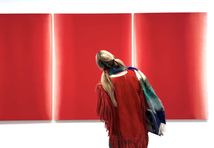Death of the Author: Birth of the Museum
- The Courtauldian
- Mar 18, 2016
- 3 min read
Death and Memory: Soane and the Architecture of Legacy is the current exhibition at The Sir John Soane’s Museum. I visited last term for a private view and curator’s talk during a Friday Late event.
The Museum at 13 Lincoln’s Inn Fields is a testament to the legacy of nineteenth-century British architect Sir John Soane. After his death on 20th January 1837, the doors of the building that once served as his family home and architectural office were opened to the public as it assumed its new museum function. It was Soane’s express will that the contents of the museum remain intact as far as possible. The resultant museum whose collection display has remained relatively unchanged throughout the ages, offers to the visitor a series of rooms that read like riddles. These spaces remain crammed with an eclectic mix of objects (paintings, drawings, ancient vases, plaster casts of sculptures, architectural models, fragments of buildings, intricately decorated furniture, numerous mirror and more), which are endowed with a sense of preciousness by their careful arrangement. The current exhibition assists the visitor in drawing meaning from this amassment of things as they uncover how the theme of ‘Death and Memory’ is woven into the fabric of the museum.
During his career Soane became increasingly preoccupied by the concept of memorialisation and the death of his beloved wife Eliza in 1815 amplified these concerns. The current exhibition marks the two hundred year anniversary of Eliza’s death. During her talk Helen Dorey introduced us to the complex nature of the Soane family relationships, revealing the blurred nature of his personal and professional life. The exhibition reveals that Soane believed the life failures of their son George had a major impact on the deterioration of his wife’s health.
As Dorey delivered her account of the museum, the exhibition and Soane’s attitude towards his own legacy, I became increasingly aware of my place within the museum as a visitor—conscious of the ways in which Soane would have expected and hoped for me to view it. Dorey pointed out how the ancient vases perched on high shelves in the front dining room echo the format of a miniature model of an Etruscan tomb displayed in the exhibition. The room’s tomb-like quality is heightened by the knowledge of the fact that after his wife’s death Soane placed her coffin in this room for several days prior to the funeral. Through Dorey’s interpretation Soane’s voice was becoming increasingly recognisable.
The concept of the museum as a mausoleum, a site that deadens any object that enters it and effectively kills creative ingenuity, was an anxiety present at the foundation of the earliest museums in the seventeenth century. It is a concept perhaps most familiar to us from the Futurist manifestos like Fillipo Marinetti’s and permeated the literature of museum studies in the twentieth century. Although this museum’s identity seems intricately bound up in concepts of death, the site is not a stagnant time capsule but rather a place of inspiration. The museum continues to uphold its original mission as an active site of inspiration for contemporary architects—its link to The Bartlett is just one example of this. Even a museum whose founding ideals prescribe a strict framework on its curation is embracing the need to address contemporary art. Paddy Hartley recently exhibited a beautiful piece entitled Papaver Rhoeas. The work is tied to the theme of death and memory and was exhibited in what originally functioned as Soane’s breakfast room.
Although Soane specified that the museum’s architectural fabric and collection display should remain intact, naturally there have been exceptions to this ideal and over time curatorial decisions resulted in various alterations. This raises an interesting question. To what extent are museum leaders obliged to honour the ideals of their museum founders? The current identity of this museum remains closely bound to its founder’s intentions; to stray from his original concept would be to lose something of its integral nature.
If you have never visited Sir John Soane’s Museum, now is the perfect time. The current exhibition eloquently conveys the nature of Soane’s attitude towards death and his anxious obsession with memorialisation, enhancing the visitor’s experience of the museum as a whole.
(Death and Memory: Soane and the Architecture of Legacy at The Sir John Soane’s Museum closes 26th March 2016)












Comments